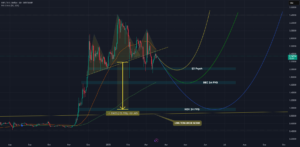Wall Street is on the edge, waiting for updates on the strike against the Detroit Three auto makers. The past week has been tumultuous, with a surprising walkout at a key Ford Motor assembly plant.
Focus on UAW President’s Update
All eyes are on United Auto Workers President Shawn Fain as he prepares to provide an update on the state of the talks. With his scheduled speech at 10 a.m. Eastern time on Friday, investors are hoping for clues on how the strike may unfold.
Unprecedented Strategy Creates Chaos
This year’s strike by the UAW against Ford, General Motors, and Stellantis is unique. Unlike previous strikes that targeted only one company, this time the union decided to simultaneously strike all three manufacturers. President Fain refers to this strategy as a “stand-up strike,” which has caused confusion, chaos, and financial difficulties for the auto makers.
Expanding Strike Scope and Disrupted Production
Starting with a limited number, approximately 12,000 workers from three plants initially walked out. However, the strike has grown significantly, with about 33,000 workers now on strike. Additionally, due to disrupted production, an additional 5,000 workers have been laid off. In total, over 38,000 people are now affected, representing more than one-fourth of the 145,000 UAW members employed by the Big Three.
Impact Hits Ford’s Largest Factory
The strike continues to make headlines, and the latest blow came when President Fain announced that the Kentucky Truck Plant of Ford would join the strike. This facility is Ford’s largest factory and generates approximately $25 billion in annual sales. The news caught Ford by surprise and left them dismayed.
Concerns and Calls for Resolution
Analysts like Jeff Windau from Edward Jones express concerns about the UAW strike strategy. He worries about the potential long-term implications of inflicting maximum pain on the auto makers, emphasizing the need for competitiveness in their respective markets. Windau stresses the importance of reaching a fair contract to ensure a balanced approach.
Shifting Dynamics and Future Demands
While President Fain has been successful in negotiations so far, securing wage increases, inflation protection, improved retirement benefits, and equality among worker classes, investors yearn for more clarity. Fain’s statements pushing for a fair contract indicate that further demands may arise during the ongoing negotiations.
In this high-stakes chess match, Fain has shown dominance in the opening and middle games. However, to truly serve the best interests of the UAW membership, an effective endgame is required.
The Impact of the UAW Strike on Automotive Stocks
Amidst ongoing negotiations between the United Auto Workers (UAW) and major automakers, concerns regarding the financial implications are growing. The UAW continues to push for better concessions from the Detroit-Three, particularly Ford Motor Company. However, there is apprehension regarding the union’s strategy and whether additional pressure will yield the desired outcomes.
Analysts are closely monitoring the situation, with John Murphy from BofA Securities expressing concern over the UAW’s actions. Murphy notes that while Ford has been accommodating thus far, the union may be attempting to secure further concessions by increasing pressure. This move, however, raises questions about the impact it may have on UAW members.
The rejection of a tentative agreement by Mack Truck workers further emphasizes this point, as they firmly believe they can attain better terms. Moving forward, it is essential for stakeholders to strike a balance between asserting their demands without alienating their workforce.
In terms of stock performance, Ford and General Motors (GM) have experienced a decline due to ongoing negotiations. Ford stock has dropped by approximately 20%, while GM stock has seen a decrease of 24% over the past three months. In contrast, Stellantis, a global company with cheaper shares, has witnessed a modest increase of approximately 7%. Nevertheless, all eyes are on Toyota Motor (TM), as it emerges as the unexpected winner amidst the strike. With no U.S.-based workers participating in the strike, Toyota’s shares have risen by 14% over the past three months.
As negotiations continue, investors and industry experts are closely monitoring the situation. The outcome of these discussions will undoubtedly shape the future of automotive stocks.


